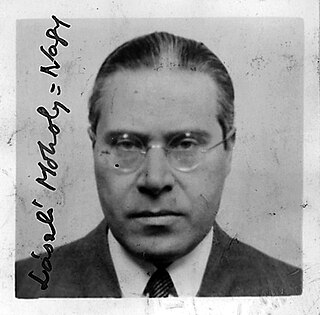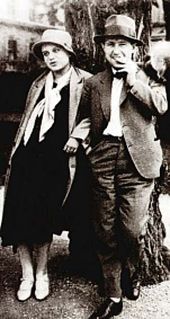 W
WAnni Albers was an American textile artist and printmaker credited with blurring the lines between traditional craft and art.Besides surface qualities, such as rough and smooth, dull and shiny, hard and soft, textiles also includes colour, and, as the dominating element, texture, which is the result of the construction of weaves. Like any craft it may end in producing useful objects, or it may rise to the level of art.
 W
WJosef Albers was a German-born artist and educator. He taught at the Bauhaus and Black Mountain College, headed Yale University's department of design, and is considered one of the most influential teachers of the visual arts in the twentieth century.
 W
WOtti Berger was a textile artist and weaver. She was a student and later teacher at the Bauhaus.
 W
WMarianne Brandt was a German painter, sculptor, photographer, metalsmith, and designer who studied at the Bauhaus art school in Weimar and later became head of the Bauhaus Metall-Werkstatt in Dessau in 1927. Today, Brandt's designs for household objects such as lamps, ashtrays and teapots are considered timeless examples of modern industrial design. She also created photomontages.
 W
WMarcel Lajos Breuer, was a Hungarian-born modernist architect and furniture designer. At the Bauhaus he designed the Wassily Chair and the Cesca Chair, which is “among the 10 most important chairs of the 20th century.” Breuer extended the sculpture vocabulary he had developed in the carpentry shop at the Bauhaus into a personal architecture that made him one of the world's most popular architects at the peak of 20th-century design. His work includes art museums, libraries, college buildings, office buildings, and residences. Many are in a Brutalist architecture style, including the former IBM Research and Development facility which was the birthplace of the first personal computer. He is regarded as 'one of the great innovators of modern furniture design' and 'one of the most-influential exponents of the International Style'.
 W
WKarl Friedrich Alfred Heinrich Ferdinand Maria Graf Eckbrecht von Dürckheim-Montmartin was a German diplomat, psychotherapist and Zen master. A veteran of World War I, he was introduced to Zen Buddhism early in life. After obtaining a doctorate in psychology, he became an avid supporter of the Nazi Party. Following World War II he was imprisoned in Japan which transformed him spiritually. Upon returning to Germany he became a leading proponent of the Western esoteric spiritual tradition, synthesizing teachings from Christian Mysticism, Depth Psychology and Zen Buddhism.
 W
WLyonel Charles Feininger was a German-American painter, and a leading exponent of Expressionism. He also worked as a caricaturist and comic strip artist. He was born and grew up in New York City, traveling to Germany at 16 to study and perfect his art. He started his career as a cartoonist in 1894 and met with much success in this area. He was also a commercial caricaturist for 20 years for magazines and newspapers in the USA and Germany. At the age of 36, he started to work as a fine artist. He also produced a large body of photographic works between 1928 and the mid 1950s, but he kept these primarily within his circle of friends. He was also a pianist and composer, with several piano compositions and fugues for organ extant.
 W
WCarl Fieger was a German architect, designer, and teacher at the Bauhaus.
 W
WAlfréd "Fred" Forbát was a Hungarian-born architect with significant work in Germany and Sweden.
 W
WWalter Adolph Georg Gropius was a German architect and founder of the Bauhaus School, who, along with Alvar Aalto, Ludwig Mies van der Rohe, Le Corbusier and Frank Lloyd Wright, is widely regarded as one of the pioneering masters of modernist architecture. He is a founder of Bauhaus in Weimar (1919). Gropius was also a leading architect of the International Style.
 W
WJosef Hartwig (1880–1956) was a Bauhaus sculptor and Nazi Party member best known for his 1923 minimalist chess set design, known as Bauhaus-Schachspiel in German, or Bauhaus chess in English.
 W
WJohannes Itten was a Swiss expressionist painter, designer, teacher, writer and theorist associated with the Bauhaus school. Together with German-American painter Lyonel Feininger and German sculptor Gerhard Marcks, under the direction of German architect Walter Gropius, Itten was part of the core of the Weimar Bauhaus.
 W
WWassily Wassilyevich Kandinsky was a Russian painter and art theorist. Kandinsky is generally credited as the pioneer of abstract art. Born in Moscow, he spent his childhood in Odessa, where he graduated at Grekov Odessa Art school. He enrolled at the University of Moscow, studying law and economics. Successful in his profession—he was offered a professorship at the University of Dorpat —Kandinsky began painting studies at the age of 30.
 W
WPaul Klee was a Swiss-born German artist. His highly individual style was influenced by movements in art that included expressionism, cubism, and surrealism. Klee was a natural draftsman who experimented with and eventually deeply explored color theory, writing about it extensively; his lectures Writings on Form and Design Theory, published in English as the Paul Klee Notebooks, are held to be as important for modern art as Leonardo da Vinci's A Treatise on Painting for the Renaissance. He and his colleague, Russian painter Wassily Kandinsky, both taught at the Bauhaus school of art, design and architecture in Germany. His works reflect his dry humor and his sometimes childlike perspective, his personal moods and beliefs, and his musicality.
 W
WMax Krehan was a German Master Potter in Dornburg, Germany, who, in 1920, was appointed the Lehrmeister for the pottery workshop at the Bauhaus school in Weimar.
 W
WOtto Lindig was a German master potter who was a student and later a workshop manager at the famous Bauhaus art school in Weimar, Germany.
 W
WGerhard Marcks was a German artist, known primarily as a sculptor, but who is also known for his drawings, woodcuts, lithographs and ceramics.
 W
WAdolf Meyer was a German architect.
 W
WHans Emil "Hannes" Meyer was a Swiss architect and second director of the Bauhaus Dessau from 1928 to 1930.
 W
WLudwig Mies van der Rohe was a German-American architect. He was commonly referred to as Mies, his surname. Along with Alvar Aalto, Le Corbusier, Walter Gropius and Frank Lloyd Wright, he is regarded as one of the pioneers of modernist architecture.
 W
WLászló Moholy-Nagy was a Hungarian painter and photographer as well as a professor in the Bauhaus school. He was highly influenced by constructivism and a strong advocate of the integration of technology and industry into the arts. The art critic Peter Schjeldahl called him "relentlessly experimental" because of his pioneering work in painting, drawing, photography, collage, sculpture, film, theater, and writing.
 W
WGeorg Muche was a German painter, printmaker, architect, author, and teacher.
 W
WWalter Peterhans was a German photographer best known as a teacher and course leader of photography at the Bauhaus from 1929 until 1933, and at the Reimann School in Berlin under Hugo Häring.
 W
WLilly Reich was a German modernist designer. She was a close collaborator with Ludwig Mies Van der Rohe for more than ten years in the late 1920s and '30s.
 W
WAlexander Schawinsky, known as Xanti Schawinsky was a Swiss painter, photographer and theatre designer. An alumnus of the Bauhaus, Schawinsky belonged to the circle around Bauhaus founder and architect Walter Gropius.
 W
WHinnerk Scheper,, as 'Gerhard Hermann Heinrich Scheper; died 5 February 1957 in Berlin) was a German colour designer, mural painter, architectural colorist, non-fiction author, photographer, monument conservator, restorer, state curator and urban planner.
 W
WOskar Schlemmer was a German painter, sculptor, designer and choreographer associated with the Bauhaus school.
 W
WJoost Schmidt was a teacher or master at the Bauhaus and later a professor at the College of Visual Arts, Berlin. He was a visionary typographer and graphic designer who is best known for designing the famous poster for the 1923 Bauhaus Exhibition in Weimar, Germany.
 W
WLothar Schreyer was a German artist, writer, editor, stage designer and gallery owner. He was the first Master of the stagecraft workshop at the Bauhaus art school.
 W
WGunta Stölzl was a German textile artist who played a fundamental role in the development of the Bauhaus school's weaving workshop. As the Bauhaus' only female master she created enormous change within the weaving department as it transitioned from individual pictorial works to modern industrial designs. Her textile work is thought to typify the distinctive style of Bauhaus textiles. She joined the Bauhaus as a student in 1919, became a junior master in 1927. She was dismissed for political reasons in 1931, two years before the Bauhaus closed under pressure from the Nazis.
 W
WKarel Teige was a Czech modernist avant-garde artist, writer, critic and one of the most important figures of the 1920s and 1930s movement. He was a member of the Devětsil (Butterbur) movement in the 1920s and also worked as an editor and graphic designer for Devětsil's monthly magazine ReD. One of his major works on architecture theory is The Minimum Dwelling (1932).
 W
WHans Wittwer was a Swiss architect who worked in Germany and who taught architecture at the Bauhaus art school in Dessau. He was a proponent of functionalist architecture; the idea that form follows function. He worked with the Bauhaus director Hannes Meyer both at the school and in a joint architectural practice in Basel. He also taught at the Kunstgewerbeschule Burg Giebichenstein in Halle.
 W
WPiet Zwart was a Dutch photographer, typographer, and industrial designer.